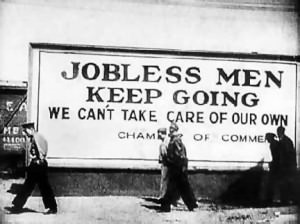Return to Black Tuesday: Surviving the Great Depression
Differences between the economic recession today and the one from 1930
By Chantelle (Tilly) Wark, Staff Writer
The people of today are caught up in a world where we think only of the now, and mostly of ourselves. We gripe about the most menial of things, while forgetting about how fortunate we really are. Sure, the aftermath of the recession in 2008 is still taking its toll on Canada, but at least we still have a fighting chance at putting some well-earned money in the bank.
Sometimes, we do what we must to make ourselves more marketable, and to gain that much needed experience that will allow us to move forward in our lives. Personally, volunteering and job placement agencies are the required routes at the moment. It may not be particularly preferable, but sometimes volunteering or temping is necessary.
In retrospect, the situations caused by the recession could have been much worse. Today, we’re surviving relatively easily. But 83 years ago, those living in Canada and the United States weren’t quite as fortunate.
The Beginning
Who knew that the decade known as the Roaring Twenties would come to an abrupt halt on October 29, 1929? But during the ’20s, everyone from the wealthy to the average citizen was putting their money and faith in the stock market, which was producing stellar results at the time.
According to the Canada History website, an investing opportunity known as “buying on margin” allowed investors to put down as little as 10 percent on a stock’s purchase. The buyer would have no need to worry about the remainder of the payment unless the stockbroker made a margin call. As prices and stocks were doing well, very few of these calls were made until autumn 1929.
A swing throughout the stocks in September 1929 led to much nervousness and anxiety within the stock market world. Come October 24, on what would later be known as Black Thursday, the margin calls that had been few quickly became many. Brokers started to seek the remainders of their funds in order to cover their own positions, but the calls made were too many too late. The next week, Black Tuesday was born.
My great-grandmother Jean Lowden was barely sixteen-years-old when the stock markets came crashing down. A few months earlier, having finished high school, she had spent the summer of 1929 living in the United States with one of her sisters. Had her mother not insisted that she return home to Canada after the summer was over, Great- Gram’s survival story could have been very different. Now 99-years-old, her Great Depression experience educates more than any textbook or historian ever could.
Sitting down to speak with her, I learned just how fortunate my great- grandmother had been, along with how grateful she was toward her boss.
When asked how her family fared, with a shrug of the shoulders, she replied that they had managed. Her dad had been admitted into the Ontario Hospital due to health complications, while her mother worked any job she could get.
As for Great-Gram, she was lucky enough to have a job where she worked four weeks on and two weeks off. ”There was two girls in the office, and so you did both jobs when you were working, and when you were off, the other girl did your job too,” she described. “You just worked harder.”
As many of Canada’s citizens were pining for a means of bringing in a bit of money, Great-Gram was more than happy to work that little bit harder during the weeks her co- worker was off.
No Place to Call Home
Many people during the Depression were evicted from their homes because they couldn’t afford to pay their mortgages. In his piece “Unemployment and Relief in Ontario,” H. M. Cassidy reported, “Hundreds of men in Toronto had no place of abode, and slept out of doors.”Great-Gram’s mother didn’t have herself a steady home during the depression either. Instead, she would rotate taking up residence with each of her grown children.
My great- grandmother was quite fortunate, though, as she had herself a place to reside. She used to board with her older sister, Vanessa, with whom she had been quite close. During the weeks Great-Gram had an income, Vanessa would charge a small rent. “The weeks I wasn’t working, she didn’t charge me,” recalled Great-Gram. “ Yes, I got help along the way.”
Undoubtedly the money for board was welcomed. Although she probably doesn’t realize it, Great-Gram did her share of, “helping along the way” as well.
During the Great Depression, many people evicted from their homes took to living in empty railcars, along with makeshift shanties. The housing complaints people have today, such as a lack of space, size or preferable location, suddenly seem pretty petty in comparison to this.
A Bunch of Baloney
My great- grandmother now resides in a retirement residence, so interacting with other residents is a regular occurrence for me. One of the other residents who is a friend of Great-Gram’s, Joan, was also a child of the Depression. As such, she had a distinct memory that she wanted to share.
Joan had asked Great-Gram if she remembered getting blue coupons in the mail. Great- Gram, cursing her memory, said that she couldn’t remember.
Joan went on to describe how families would receive blue coupons, or what we know as food stamps, for meat. She remembered waiting in lines that seemed to go on for miles on end, just to use your stamps to pick up some meat. Her father would always use the coupons to purchase baloney, since it was the cheapest, and therefore he could get more.
“He’d always fry it,” said Joan of her father prepping meals of baloney. “I hated it that way the most.”
Nowadays, Joan refuses to eat baloney as she had more than her fill of it during the Depression. She claims she’ll only eat if now if it’s the kind with garlic. E then, she would really have to really think about it.
The End of the Depression with the Beginning of the War…
The argument has been made that the advent of the Second World War is what helped to bring about the end of the Great Depression. After all, men were needed to enlist in the military, while many women went to work in munitions factories, became nurses, or trained as home guards, should Canada need to be defended while the men were at war.
People had an income again, something that had eluding residents for so long; however, the war also brought about more food rationing, along with pricing controls. Because of this, the question has sometimes been raised of when the Great Depression truly came to an end.
Although there is no right or wrong answer, my great-grandmother sides with the advent of Second World War theory: people were working steadily again, and that was the main thing. For her, that was enough.
Return to the Present
The recent recession has certainly taken its toll on our nation, but Great-Gram’s Depression education has really helped to put things into perspective. Sure, finding steady work is proving difficult, especially with many of the available opportunities being far from preferable, but at least there are still potential jobs.
We still have our homes, as well as the bulk of our dignity. Most important, though, we don’t have to live off baloney!
Better known by my alias “Tilly,” I’m a proud Canadian who’s sixth- generation on the family homestead. I’m currently working on my B.A in English with Athabasca University by correspondence, and I firmly believe in using our freedom of speech to its fullest potential (it’s just as important as voting). For more of my idiosyncrasies, feel free to check out the following:
Twitter: @ChantelleTillyW
A Paper Voice (http://apapervoice.blogspot.com)
Linked In: Chantelle (Tilly) Wark
YouTube: Supermaam
Sources
– “Crash” Canada History Online
– “Depression” Gage Canadian Dictionary. 1997 Ed.
– Lowden, Jean. Great Depression Survivor. Caledonia, ON. 9 Sept. 2012
– Mennill, Paul. The Depression Years: Canada in the 1930’s. Scarborough, ON. 1978


























Share the post "Return to Black Tuesday: Surviving the Great Depression"